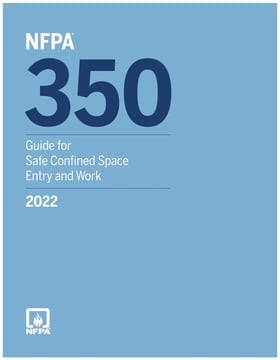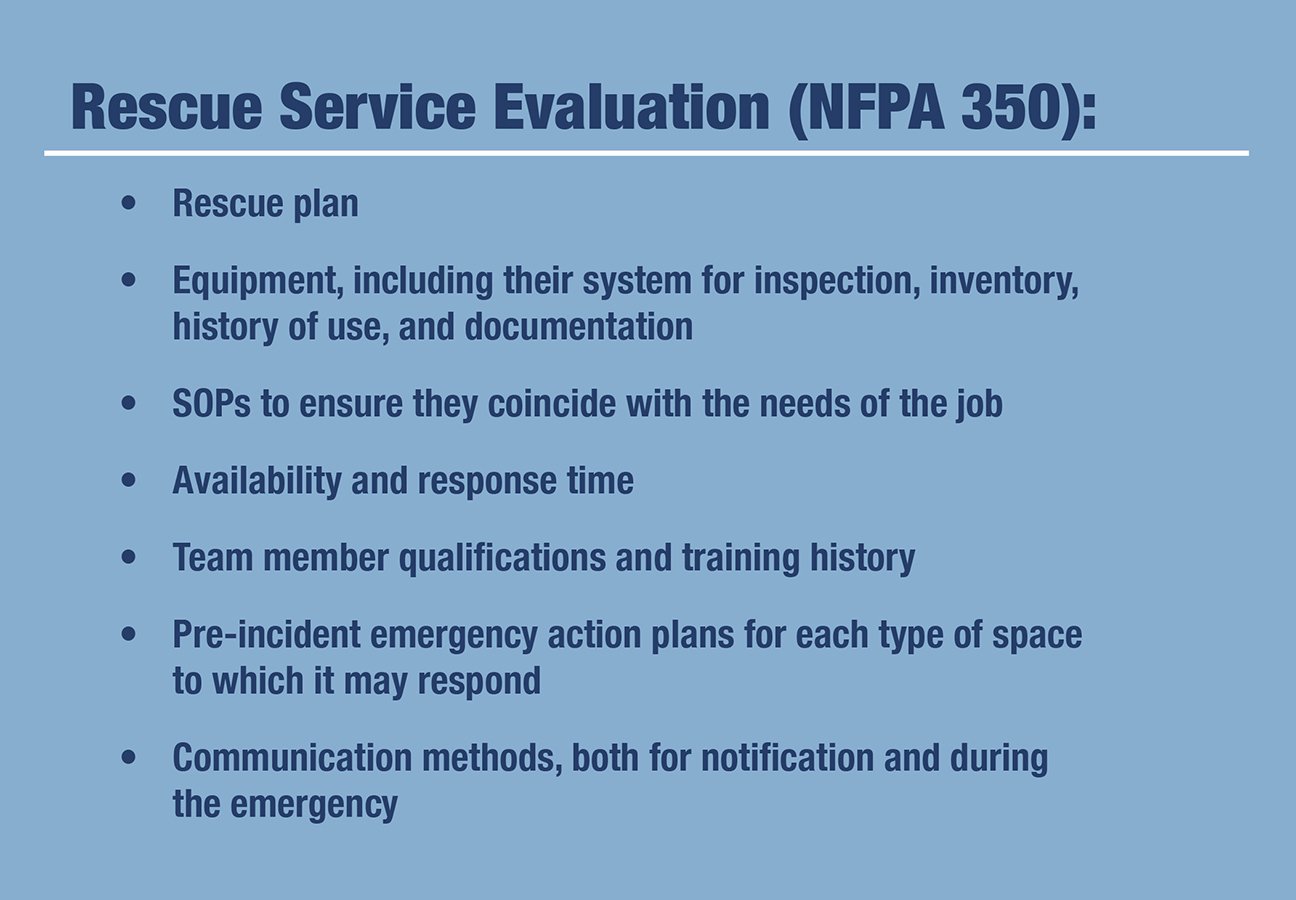What Does NFPA Have to Say about Confined Spaces? (Part 2)

A How-To Guide for Selecting a Rescue Service
In the first article in this series, we provided a high-level overview of NFPA 350 Guide for Safe Confined Space Entry and Work. We discussed the expanded roles on a confined space entry team with the inclusion of positions such as the Ventilation Specialist, Gas Tester, Standby Worker, etc. We also delved into the standard’s tiered response time and capability requirements for rescue, based on the hazards of the space.
In this article, we will focus on the rescue section of the standard. It provides broad coverage of the topic and if you have not read the standard, we highly recommend that you do so. It takes the “safe” part of its title very seriously, not only as it pertains to rescue, but across the board in everything related to confined space entry.
This article will focus on what the standard has to say about how an organization should select a rescue services provider if they are not going to perform rescue with in-house personnel. Roco Rescue thinks this of particular importance because there are many companies on the market that offer rescue services for confined space entry, and with any open market, there are vast differences in the quality of services they provide.
For safety managers who determined to ensure that they select a quality rescue provider, NFPA 350 provides an excellent framework for making that decision. If the safety manager rigorously applies the guidelines for auditing rescue programs contained in NFPA 350, they can rest assured that they are making an informed decision when selecting a Confined Space Rescue Service.
The need to evaluate rescue service providers is not new or limited to NFPA 350. OSHA 1910.146 requires employers to “evaluate a prospective rescuer's ability to respond to a rescue summons in a timely manner, considering the hazard(s) identified.” They shall “evaluate a prospective rescue service's ability, in terms of proficiency with rescue-related tasks and equipment, [and] to function appropriately while rescuing entrants from the particular permit space or types of permit spaces identified.” Further, employers shall “select a rescue team or service from those evaluated that has the capability to reach the victim(s) within a time frame that is appropriate for the permit space hazard(s) identified, [and] is equipped for and proficient in performing the needed rescue services.”
The mandate for due diligence is there, but the standard is a bit vague and subject to broad interpretation. NFPA 350 on the other hand, does a really good job of filling in the voids and eliminating gray areas.
The first thing NFPA 350 requires is that the rescue provider ”should meet all requirements of the technician level confined space rescue chapter in NFPA 1670” Standard on Operations and Training for Technical Search and Rescue Incidents. Technician level training from a reputable company is a significant investment in both time and money. This will effectively eliminate companies that want to simply have someone standing by at a tripod winch and consider them the “rescuer.”
The mandate for due diligence is there, but the standard is a bit vague and subject to broad interpretation. NFPA 350 on the other hand, does a really good job of filling in the voids and eliminating gray areas.
For those services that meet that first requirement, this is where the standard really gets interesting. The standard then calls for an audit of the prospective rescue provider by a designated person or team. Those conducting the audit should be “persons trained in or familiar with rescue operations and medical provisions at a level commensurate with the recommendations of this guide [NFPA 350] for rescue team members.” What the standard basically says is that the person or team conducting the audit should know what they are looking at from a rescue perspective.
The audit recommended by NFPA 350 is thorough. It should include, but is not limited to, an evaluation of the rescue service’s:

In addition to the audit of plans and records, NFPA 350 recommends that the prospective provider submit to a performance evaluation and declares that it is the “principal means of deciding who is qualified among a group of prospective rescue service providers.”
The performance evaluation suggested by NFPA 350 goes far beyond knot tying and equipment usage. The evaluation should involve simulated rescues with manikins removed from actual representative spaces. Further, the teams being evaluated should be the actual teams that will be on standby in all staffing combinations. The standard acknowledges that “this may require multiple evaluations to ensure that all team member compositions will provide the appropriate capability for confined space rescue.”
Once a rescue service is selected, the evaluation does not stop there. The standard calls for annual evaluations, or whenever there are changes to operations or regulatory requirements.
In addition to evaluating rescue capabilities, the performance evaluation should also take into account patient care. The prospective service should demonstrate their ability to address both life-threatening and non-life-threatening conditions and maintain effective treatment until the patient is turned over to definitive care providers.
Once a rescue service is selected, the evaluation does not stop there. The standard calls for annual evaluations, or whenever there are changes to operations or regulatory requirements.
Following NFPA 350’s guidelines is the surefire way to select a rescue services provider. Are these requirements rigorous? You bet. To borrow a saying, this method separates the wheat from the chaff. At the end of the day, it ensures that should an emergency occur, your confined space rescue provider will give the injured entrant the best chance possible for a positive outcome.
NFPA 350 serves as a comprehensive guide for safe practices related to confined space entry, work, and rescue. It provides procedures and best practices for safely entering and working in confined spaces. It also includes guidelines for confined space rescue operations, which are critical for the safety of entrants.It provides a dependable template for selecting a qualified rescue service. Everyone involved in confined space operations should consider NFPA 350 a “must-have” resource.




